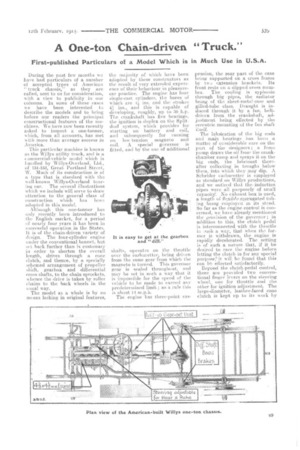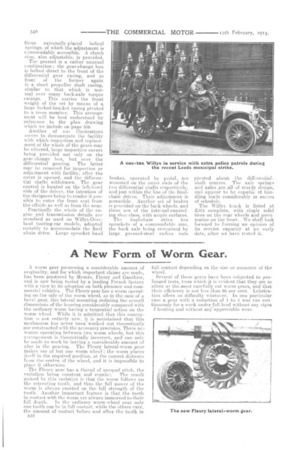A One-ton Chain-driven "Truck."
Page 5

Page 6

If you've noticed an error in this article please click here to report it so we can fix it.
First-published Particulars of a Model Which is in Much Use in U.S.A.
During the past few months we have had particulars of a number of accepted types of American " truck chassis," as they are called, sent to us for consideration, with a view to publicity in our columns. In some of these. cases we have been interested to describe the models and to bring before our readers the principal constructional features of the machines. We have now been recently asked to inspect a one-tonner, which, from all accounts, has met with more than average success in America.
This particular machine is known as the Willys utility truck, and is a commercial-vehicle model which is handled by Willys-Overland. Ltd., of 151-153, Great Portland Street, W. Much of its construction is of a type that is standard with the well-known Willys-Overland tour ing car. The several illustrations which we include will serve to draw attention to the general class or construction which has bee,i adopted in this model.
Although a is o n e-tonner has only recently been introduced to the English market., for a. period ef nearly four years it has been in SIT'ecessful operation in the States. It is of the chain-driven variety of design. The four-cylinder engine under the conventional bonnet, but set back further than is customary in order to shorten the overall length, drives through a cone clutch, and thence, by a specially schemed arrangement of propeller shaft, gearbox and differential eross-shafts, to the chain sprockets, whence the drive is taken by roller chains to the back wheels in the usual way.
The model as a whole is by no means lacking in original features, the majority of Nvhich have been adopted by these constructors as the result of very extended experience of their behaviour in pleasureear practice. The engine has four single-cast cylinders, the bores of which are 41 ins, and the strokes ins., and this is -capable of developing, roughly, up to 30 h.p. The crankshaft has five bearings, the ignition is duplex on the. Splitdoll system, which provides for starting on battery and coil, and subsequently for running on low-tension magneto and coil. A special governor is fitted, and by the use of additional
shafts, operates on the throttle over the carburetter, bring driven from the same. gear from which the magneto is turned. This governor gear is sealed throughout, and may be set in such .a way that it is impossible for the speed of the vehicle to be made to exceed any predetermined limit ; as a rule this is about 1-1 ni.p.h.
The engine has three-point sus
pension, the rear part of the case being supported on a cross frame by two extension brackets. Its front rests on a dipped-cross member. The cooling is syplionie through big .pipes, the radiator being of the sheet-metal-ease and gilled-tube class. Draught is induced through it by a fan, beltdriven from the crankshaft, adjustment being effected by the eccentric mounting of the fan shaft
The lubication of the big ends and main bearings has been matter of cerasiderable care on the part of the designers ; a force pump draws the oil frow the crankchamber sump and sprays it on the big ends, the lubricant thereafter collecting in troughs below them, into which they a/air dip. A Schebler carburetter is employed as standard on Willys productions, and we noticed that the-induction pipes were all purposely of small c-apacity No exhaust box is used, a. length of flixihlo,ccruga.teA tub. ;lug being employed in its stead. So far as the engine control is concerned, we have alreadymentioned the provision of the governor ; in addition to this, the clutch pedal is interconnected with the throttle in euch a way, that when the former is withdrawn, the engine is rapidly decelerated. The setting is or such a nature that, if it be desirod to race the engine before letting the dutch, in for any special purpose-,' it will be found that this can 1.1-'3 effected satisfactorily.
Beyond the clutch-pedal control, there are provided two conventional finger levers on the steering wheel, one for throttle and the other for ignition adjustment. The large-diameter, leather-faced cone clutch is kept up to its work by
three externally-placed helical springs, of which the adjustment is ciinmeudably accessible. A clutch stop, also adjustable, is provided.
The gearset is a rather unusual combination; the gear-change box is bolted direct to the front of the differential gear casing, and in front of the former again is a short propeller shaft casing, similar to that which is normal over many back-axle torque casings. This carries the front weight of the set by means of a, large forked-bracket casing pivoted to a cross member. This arrangement will be best understood by reference to the plan drawing which we include on page 539.
Another of our illustrations serves to demonstrate the facility wit-h which inspection and replacement of the whole of the gears may be effected, large inspection covers being provided not only on the gear change box, but over the differential gearing. The latter may be removed for inspection or adjustment with facility, after the cover is opened, and the differential shafts withdrawn. The gear control is located on the left-hand side of the driver, the intention of the designers being to render it possible to enter the front seat from the offside as well as from the near.
Practically the whole of the engine and transmission details are standard as used on Willys-Overland touring-car models, adapted suitably to accommodate the final chain drive. Large sprocket band brakes, operated by pedal, are mounted on the outer ends of the two differential shafts respectively, and just within the line of the finalchain drives. Their adjustment is accessible. Another set of brakes is provided on the hack wheels, and these are of the internal-exnareding shoe class, with ample surfaces.
The final-chain drive has sprockets of a commendable size, the hack axle being restrained by large pressed-steel radius rods pivoted about the differentialshaft centres. The axle springs and axles ,are all of sturdy design, and appear to be capable el handling loads considerably in excess of schedule.
The Willys tiuck is listed at £315 complete, with single solid tires on the rear wheels and pneumatics on the front.. We shall look forward to farming an opinion of its service capacity at an early date, after we have tested it.




















